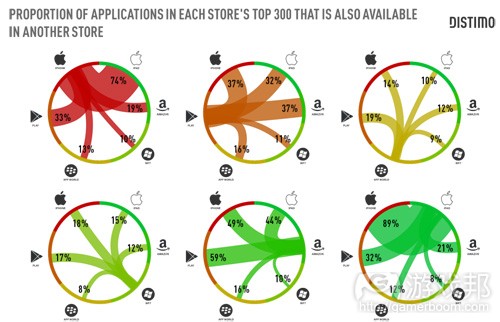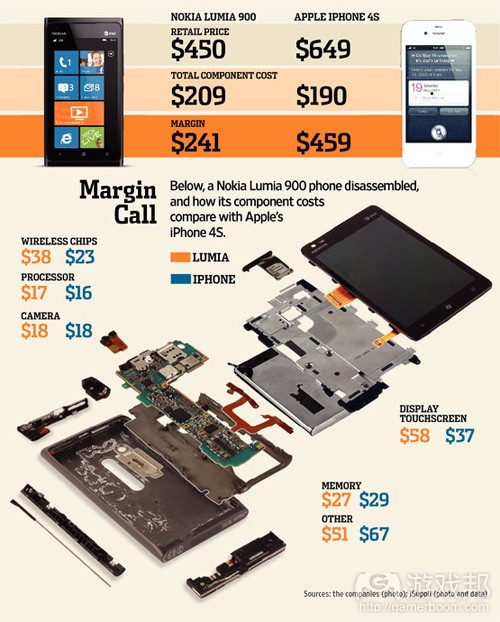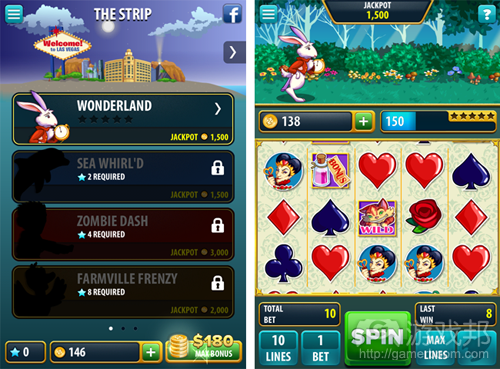每日观察:关注Lumia 900和iPhone 4S成本及利润(6.4)
1)Distimo最新报告显示,2012年4月份,在Google Play前300名热门免费应用的日下载量为400万次。而iPhone前300名免费应用的同一数据则是Google Play下载量的82%,iPad免费应用下载量是Google Play应用的20%,亚马逊App Store免费应用的这一数据是Google Play应用的10%,而Windows Phone的这一比例仅为2%。
从4月份这6家应用商店前300名免费和付费应用的分布情况可以看出,相当一部分成功手机应用已经采用跨平台战略,有30%的iPhone App Store热门应用也出现在Google Play。
2)《哈宝旅馆》开发公司Sulake最近调查报告指出,Android操作系统比iOS更受少儿群体欢迎。
Sulake调查样本为2.7万名青少年,其中约有半数智能手机用户自称是Android用户;iPhone用户所占比例则是32%,是最受欢迎的手机设备,但iOS操作系统所占份额居于Android之后。
调查发现三星正迅速追赶苹果,成为支持率最高的设备制造商之一。在非苹果用户中,有20%用户自称拥有三星手机。
据Sulake首席执行官Paul LaFontaine所称,他们从调查中发现了Android在青少年市场中的发展潜力,并决定将iOS游戏《Niko》推向Google Play平台。
3)iSuppli最新数据显示,诺基亚Lumia 900设备的制造、营销和发售成本为209美元,而该手机售价为450美元,也就是说每售一部Lumia 900,诺基亚得到的利润就是241美元。
而苹果iPhone 4S的成本却仅为190美元,但每部手机的建议零售价却可达到649美元,也就是每部iPhone 4S可带来459美元的利润。
尽管Lumia 900采用了更高及的无线芯片,更宽大的屏幕,但其利润与iPhone 4S出现如此差距的主要原因却是苹果掌握了更强大的供应商和制造商关系链。
4)据insidemobileapps报道,Zynga最近向加拿大和澳大利亚App Store发布新款iOS游戏《Zynga Slots》(游戏邦注:该游戏于5月29日就在加拿大App Store上线)。
与其他多数老虎机游戏一样,《Zynga Slots》也是一款免费增值游戏。在过去数月中,老虎机游戏在手机平台人气高涨,目前在iOS平台最热门的老虎机游戏是Playtika作品《Slotomania》,位居应用营收榜单第三名;Playtika和DragonPlay这两家公司的老虎机游戏鲜少跌出iOS和Android应用营收榜单前10名。
虽然Zynga涉猎老虎机游戏领域的时间较晚,《Zynga Poker》在2011年初时还落后于Kamagames和Self Aware Games等小型开发商的产品,但在2011年6月Zynga游戏则已跻身Android和iOS应用榜单前列。Zynga在Facebook平台的老虎机游戏同样表现不俗,据AppData数据显示,《Zynga Slingo》目前DAU为350万,MAU为1570万。
5)据techcrunch报道,手机游戏开发商Bolt Creative日前宣布《口袋上帝》漫画系列(游戏邦注:于2010年8月由Ape Entertainment发行该漫画系列的印刷型和iOS产品,目前共发行了16个版本)目前的数字销量超过60万份,其中第一个版本销量突破20万份(2012年3月最热销漫画《Avengers vs. X-men》销量也是20万份左右),其他版本的销量约8万份,已有数月时间稳居漫画排行榜前10名。
需注意的是,这里仅指该漫画的数字版本而非纸质版本,传统的纸质版本发行数量逊于数字版本,《口袋上帝漫画》应用曾在苹果App Store付费书籍榜单登顶,目前排名第19。
6)据pocketgamer报道,独立开发商Mojang成员最近透露《MinerCraft》在手机平台下载量已超过180万次,但并未区分各个时期下载情况(游戏邦注:Google Play曾为庆祝应用商店实现100亿次下载量曾推出优惠酬宾活动,将该游戏降至0.1美元出售)。
7)Interactive Advertising Bureau Europe最近针对5万名用户的调查报告显示,37%欧洲用户使用桌面电脑、手机、平板电脑和掌机而不仅仅使用PC上网。
但桌面电脑仍是用户的主要上网渠道,其上网用户占比65%(约4.269亿),而手机上网用户占比21%(约1.329亿)。
89%的挪威和瑞典人使用桌面电脑上网,其中25-44岁的群体占比44%。
与此同时,16-24岁群体使用手机上网的比例最高(达到30%);40%以上的英国用户使用手机上网。
65%受访者平均每周上网时间达14.8小时,在各个平台的上网时间分别为:
*桌面电脑–13.3小时
*手机–9.4小时
*平板电脑–9.3小时
*游戏掌机–6.8小时
40受访者认为在线品牌信息交流很重要 ,96%上网查询购物信息,87%进行网购。(本文为游戏邦/gamerboom.com编译,拒绝任何不保留版权的转载,如需转载请联系:游戏邦)
1)Introducing Distimo AppLink, Cross-Platform App Store Distribution and Marketing Made Easy
by Gert Jan Spriensma
Today we announced the global launch of Distimo AppLink, a new, easy-to-use, cross-platform app distribution service that provides developers with a one-stop shop for detailed insight into their app distribution analytics and their app sales funnel.
Developers who use Distimo AppLink can create and communicate one single short URL for apps that are available on multiple platforms, and can also keep track of consumers who are interested in their application on platforms that are not yet supported by the developer. Distimo AppLink provides app publishers with detailed statistics about their marketing campaigns and the effectiveness of different channels, and also helps consumers to easily share apps they discover with their friends, family and colleagues, independent of the other person’s mobile device.
Our latest publication, also released today, clearly shows the need for cross-platform distribution, as publishers need to opt for a multiple store strategy in order to reach more than 50% of the United States market. The highest free download volumes can be found in Google Play where the daily download volume among the top 300 most popular free applications was 4M in April 2012. Google Play was followed by the Apple App Store for iPhone (82% of the Play volume), Apple App Store for iPad (20%), Amazon App Store (10%) and Windows Phone 7 Marketplace (2%).
Many successful publishers start to develop for multiple platforms immediately, e.g. Rovio launched Angry Birds Space for Android, iOS and Mac at the same time. Moreover, successful application publishers on one platform also decide to go to other platforms like the recent addition of the Instagram and Flipboard applications on Android show. The top 300 most popular
free and 300 most popular paid applications in April in all six major app stores show that a significant part of the successful applications are already available on multiple platforms.
For example, 33% of the most popular applications in the Apple App Store for iPhone are also available in Google Play.(source:distimo)
2)Android more popular with teens than iOS says Habbo outfit Sulake
by Keith Andrew
Building on numerous consumer studies that describe a comfortable lead for Android, Habbo Hotel’s parent company Sulake has narrowed down the dataset, claiming Google’s OS is more popular with teens than iOS.
The assertion comes from a poll of 27,000 teenagers conducted by Sulake, with almost half of all smartphone owners claiming to own an Android handset.
That compares to the 32 percent who said they own an iPhone, which actually makes Apple’s handset the most popular device on the market, but iOS only the second most popular operating system.
Super Samsung
Sulake attests Samsung is fast catching Apple when it comes to the most popular manufacturer, and is the main driver behind Android’s growth.
Of those surveyed with a smartphone – which came to 49 percent – 20 percent said they own a Samsung handset.
These results prove Android’s potential for developers looking to reach a younger market, claimed Sulake CEO Paul LaFontaine, with Sulake itself deciding to bring iOS release Niko to Google Play as a result.
“The poll showed unequivocally that our teen audience is rapidly adopting smartphone devices and broadening how they access their favorite entertainment,” added LaFontaine.
“Following the success of Niko on iOS, we’ve expanded the platform availability to include Android devices based on this usage research and will continue to explore new exciting opportunities for our fanbase.”(source:pocketgamer)
3)Nokia makes $200 less on every Lumia 900 sold than Apple does with iPhone 4S
by Keith Andrew
Even if Nokia’s flagship Lumia 900 starts to sell at the same rate at Apple’s iPhone 4S, the Finnish firm could still only make half as much profit on units sold as its American rival.
That’s according to a costing analysis of the two handsets conducted by iSuppli, with the firm highlighting the difficulties a rejuvenated Nokia is having making its mark in the smartphone market.
All in the numbers
Excluding costs such as manufacturing, marketing and distribution, iSuppli’s figures suggest the cost of the components in Nokia’s Lumia 900 come in at $209, with the handset selling for $450 out of contract.
That gives Nokia a margin of $241 per device sold.
Apple’s iPhone 4S is actually cheaper to produce – iSuppli pegging component costs at $190 – but is sold at a higher RRP, retailing at $649 out of contract.
That hands Apple a healthy margin of $459 for every handset that ends up in a consumer’s pocket.
This is no happy accident for Apple, however.
iSuppli concludes that Apple is making twice as much on every iPhone sold than Nokia is its Lumia 900, but that’s because the American giant commands more of its supply chain.
All about relationships
While the Lumia 900′s more advanced wireless chips – the North American version LTE equipped – and larger screen inflate its costs, most of the difference between the two devices comes from the fact Apple is more embedded with suppliers and manufacturers than Nokia is.
Apple has been able to invest in developing new technology for its handsets over the course of the last few years, which means it controls the infrastructure behind said features.
Equipping the technology that results within its phones therefore costs Apple far less than its rivals, who in turn are forced to pay out to license it.
Indeed, many regard Apple’s ability to get quality components for its devices for less money as the work of current CEO Tim Cook, who has long focused on ensuring Apple makes as much profit from its products as possible.
Such disparity isn’t unique to Nokia, of course, and it’s likely the Finnish firm will be able to drive down costs the longer its Lumia range is on the market.(source:pocketgamer)
4) It looks like Zynga’s newest mobile game is Zynga Slots
Kathleen De Vere
Zynga Slots appears to be Zynga’s newest iOS title, if the game’s presence in the Canadian and Australian App Stores serves as proof.
We spotted the game today in the Canadian App Store, where it apparently soft-launched on May 29. After a brief playtest, the title appears to be a fairly standard slots game. Like many other titles in the genre, Zynga Slots is free-to-play and monetizes through the sale of the coins.
Currently, Playtika’s Slotomania is the most popular slots game on iOS, sitting in the No. 3 spot of the top grossing app charts. Over the past few months, slots games have become extremely popular, with offerings from Playtika and DragonPlay rarely dropping below No. 10 on the iOS and Android top grossing app charts.
Although Zynga is somewhat late to the slots game party, the company has proved on iOS that it can come from behind to overtake leading games, particularly when it comes to the casino genre. At the beginning of 2011, Zynga Poker was lagging far behind offerings from much smaller developers like Kamagames and Self Aware Games. By June, however, Zynga had surged ahead of the competition and has managed to stay at the top of the iOS and Android charts. Zynga also has slots-esque title Zynga Slingo on Facebook, which our AppData currently tracks at 3.5 million daily active users and 15.7 million monthly active users, from which to cross-promote.(source:insidemobileapps)
5)Pocket God’s Other Success: Digital Comics
Anthony Ha
Pocket God is best-known as a hit game for iOS and other smartphone platforms, but Dave Castelnuovo, head of developer Bolt Creative, says the story and characters have been embraced in another medium, too — namely, comic books.
Ape Entertainment started publishing the Pocket God comic series (both in print and on iOS) in August 2010, with a total of 16 issues so far, plus a digital-only series featuring bonus content. All told, the series has sold more than 600,000 digital copies, Castelnuovo says, with issue number one seeing more than 200,000 sales.
For an iOS game, those numbers wouldn’t be particularly impressive, but in the world of digital comics, they’re actually kind of amazing. For example, selling 200,000 copies puts Pocket God at roughly the same level as Avengers vs. X-men #1, which was the top-selling comic in March 2012. Castelnuovo says some subsequent issues have sold as many as 80,000 copies, which would place them among the top 10 comics for most months.
And here’s an important distinction: We’re talking about Pocket God’s digital sales, versus print sales for the other comics. Traditional comics publishers haven’t released much in the way of digital sales numbers, but they’re probably only a small percentage of print. In other words, judged purely on digital, Pocket God comics are probably outselling Marvel or DC’s top titles by a considerable margin. (The Pocket God Comics app has even reached #1 in paid books for the Apple App Store, and it’s currently ranked #19.)
One obvious conclusion: Releasing a comic book series based on a popular game in the same app store as the game itself, and promoting the comics in the game, will result in big sales.
Castelnuovo doesn’t argue with that, but he also attributes the series’ continuing success to making the right creative choices — even though the comic is written by Jason M. Burns and drawn by Rolando Mallada, Castelnuovo (who is clearly a big comics fan) says he takes an active role in shaping the story lines, so that they’re suitably epic and capture Pocket God’s sadistic sense of humor. (I’ve only read issue number one, but within the first few pages, several characters are killed off gruesomely, then resurrected, for laughs.)
Another key difference: Pricing. The Pocket God app, which comes with issue #1, costs 99 cents, and you can pay 99 cents to download each subsequent issue. Meanwhile, the traditional publishers don’t want to undercut their print prices, so they’re usually charging $2.99 or $3.99 for new issues. (Some older comics are available for considerably less.) Castelnuovo says that’s “just too expensive” for digital comics, especially when they’re competing with something like Angry Birds, which offers more content for just 99 cents. And although Marvel and DC are sell digital collections, Castelnuovo argues that they should be doing more to bundle dozens or even hundreds of issues together, so that readers can “blaze through them” the way that they will consume entire seasons of Mad Men or Game of Thrones.
Revenue from the comics series is dwarfed by what Bolt is making from the Pocket God game, Castelnuovo says. Still, he’s clearly pleased that it exists, and that it’s selling well: “I’d love to continue it indefinitely.”(source:techcrunch)
6)Minecraft sells over 1.8 million copies on mobile — Staff at Mojang have revealed to PocketGamer that the mobile edition of Minecraft has sold more than 1.8 million copies. The article did not detail how many of those copies were sold as part of the Google Play 10 billion downloads sale that discounted the game to $0.10 in December 2010.(source:insidemobileapps)
7)More than a third of Europeans access the web via multiple devices
by Zen Terrelonge
And 21 per cent favour the mobile phone.
The 50,000 consumer strong survey from the Interactive Advertising Bureau Europe shows internet use is now commonplace across desktops, mobiles, tablets and consoles.
In fact, 37 per cent of Europeans use all these devices – and not just a PC – to browse the web.
That said, desktop is still the dominant web source, securing 65 per cent – 426.9 million users – though mobile also achieved promising results with 21 per cent – 139.2 million users.
Age and location is a contributing factor for the device choice, with desktop use pocketing 89 per cent of Norwegians and Swedes, most used by 25-44 year-olds with 44 per cent.
Meanwhile, 16-24 year-olds are the most likely to use the mobile web with 30 per cent, and more than 40 per cent of Brits use the platform.
65 per cent of respondents spend an average of 14.8 hours online each week, broken down into:
* Desktop – 13.3 hours
* Mobile phone – 9.4 hours
* Tablet – 9.3 hours
* Games console – 6.8 hours
40 per cent think online brand communication is important as 96 per cent took to the web for shopping research and 87 per cent went through with making a purchase.(source:mobile-ent)














































 闽公网安备35020302001549号
闽公网安备35020302001549号